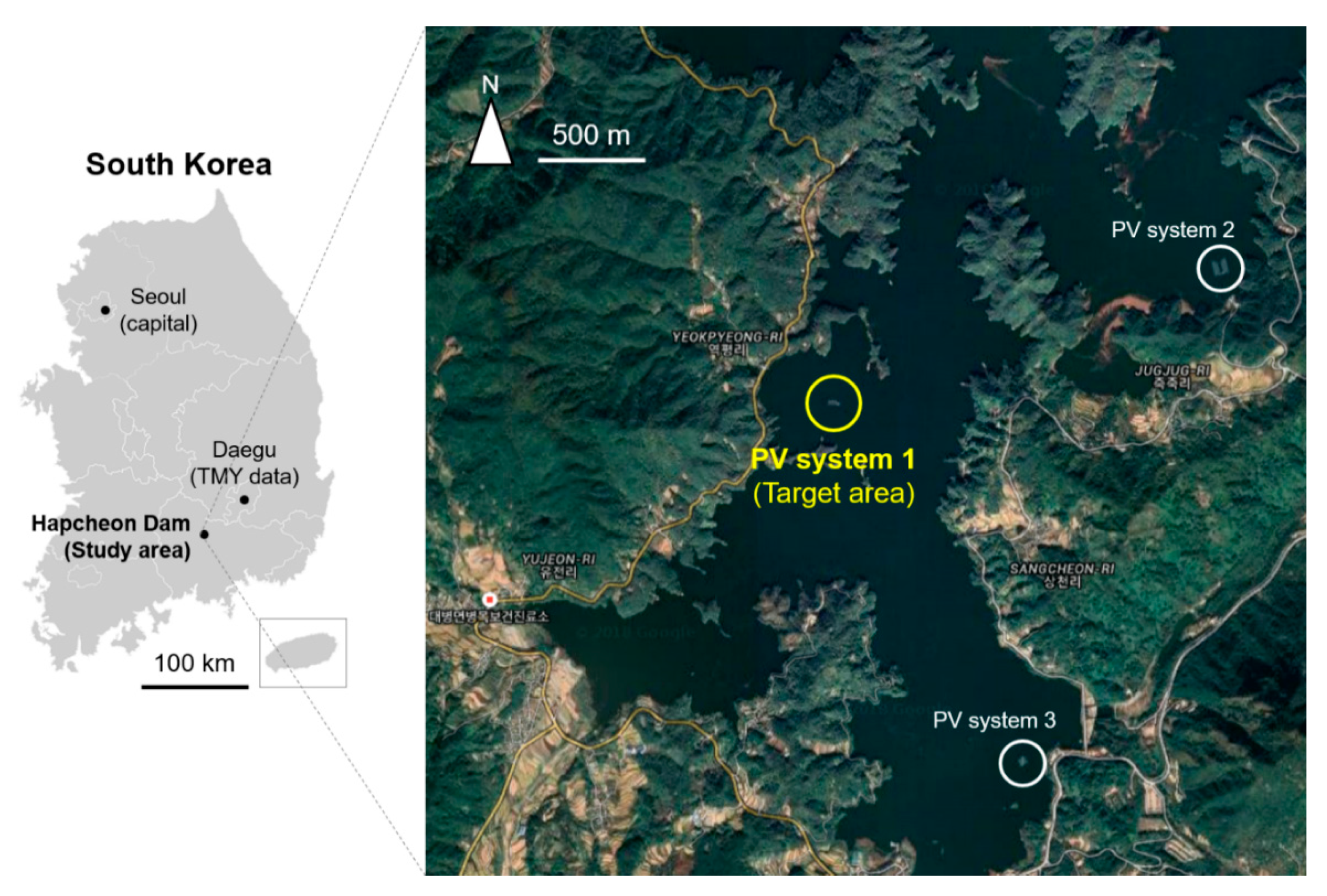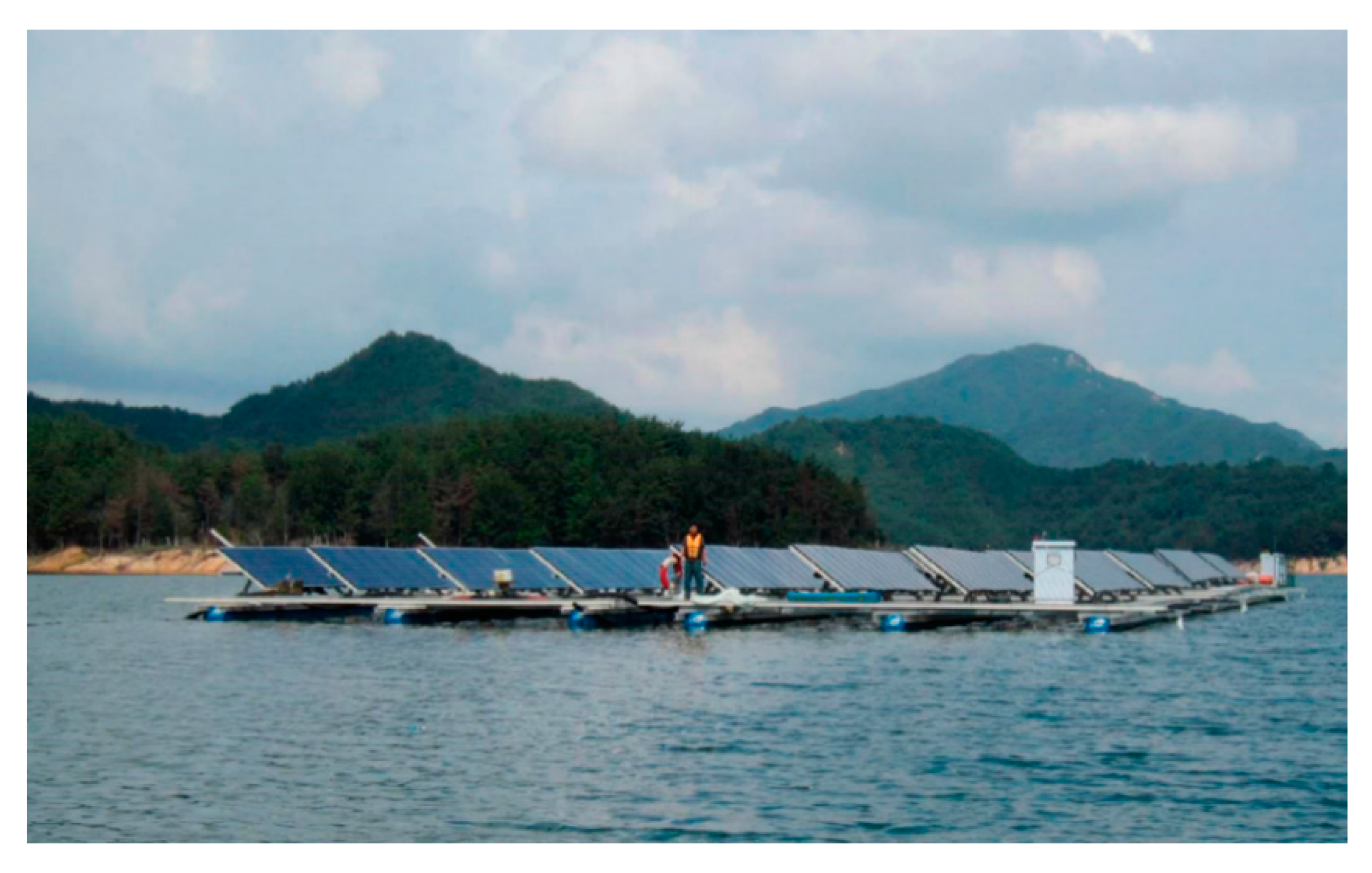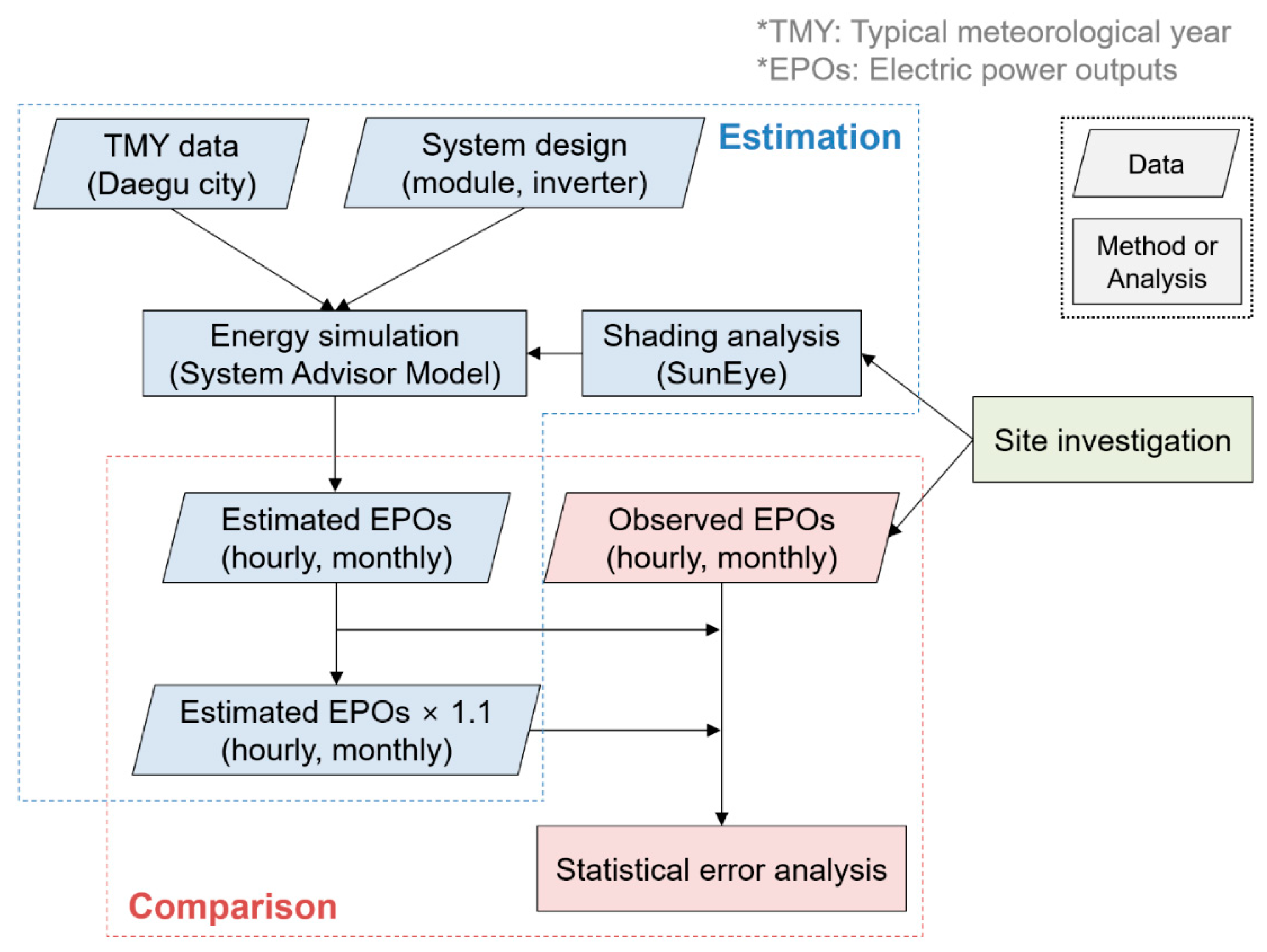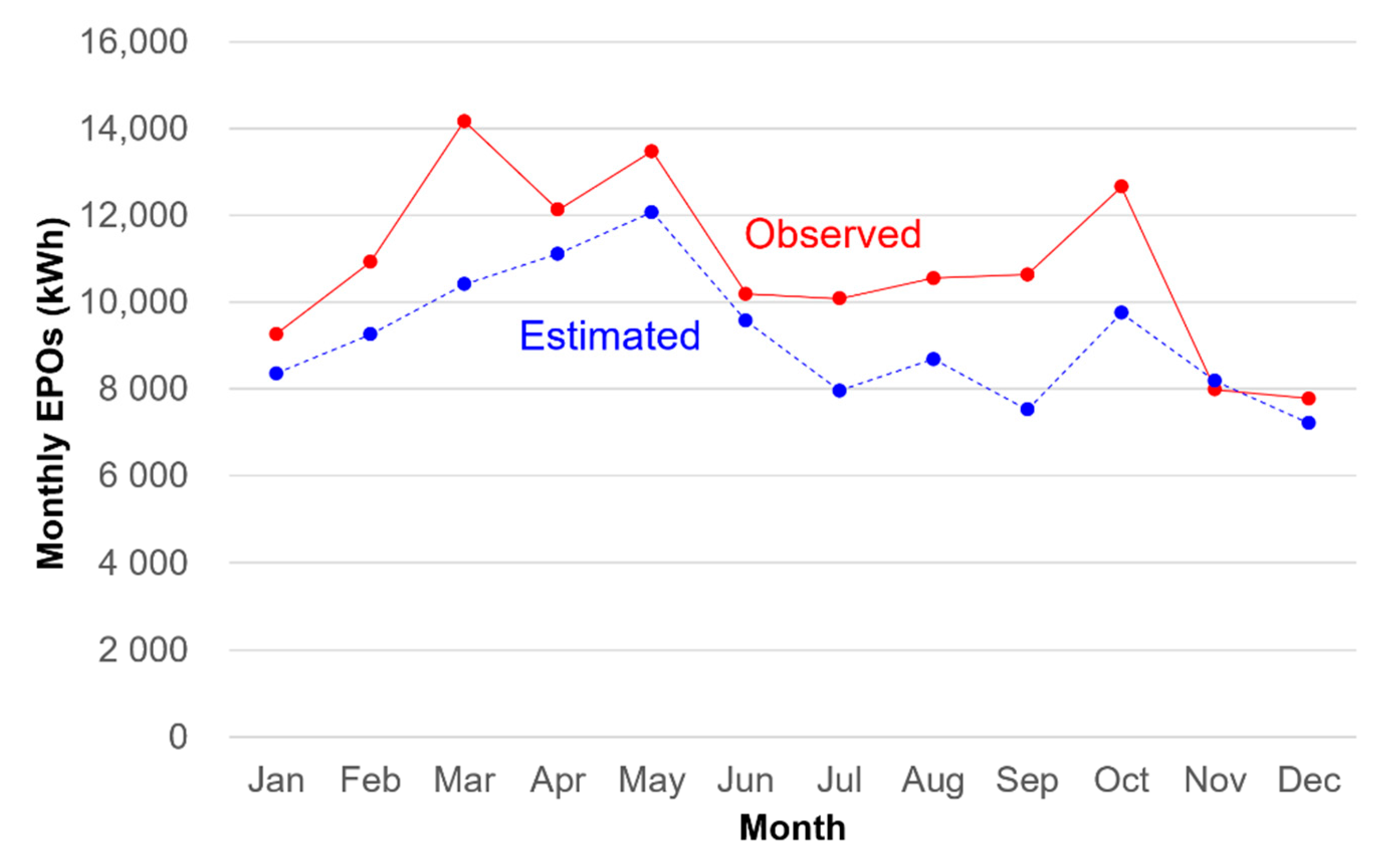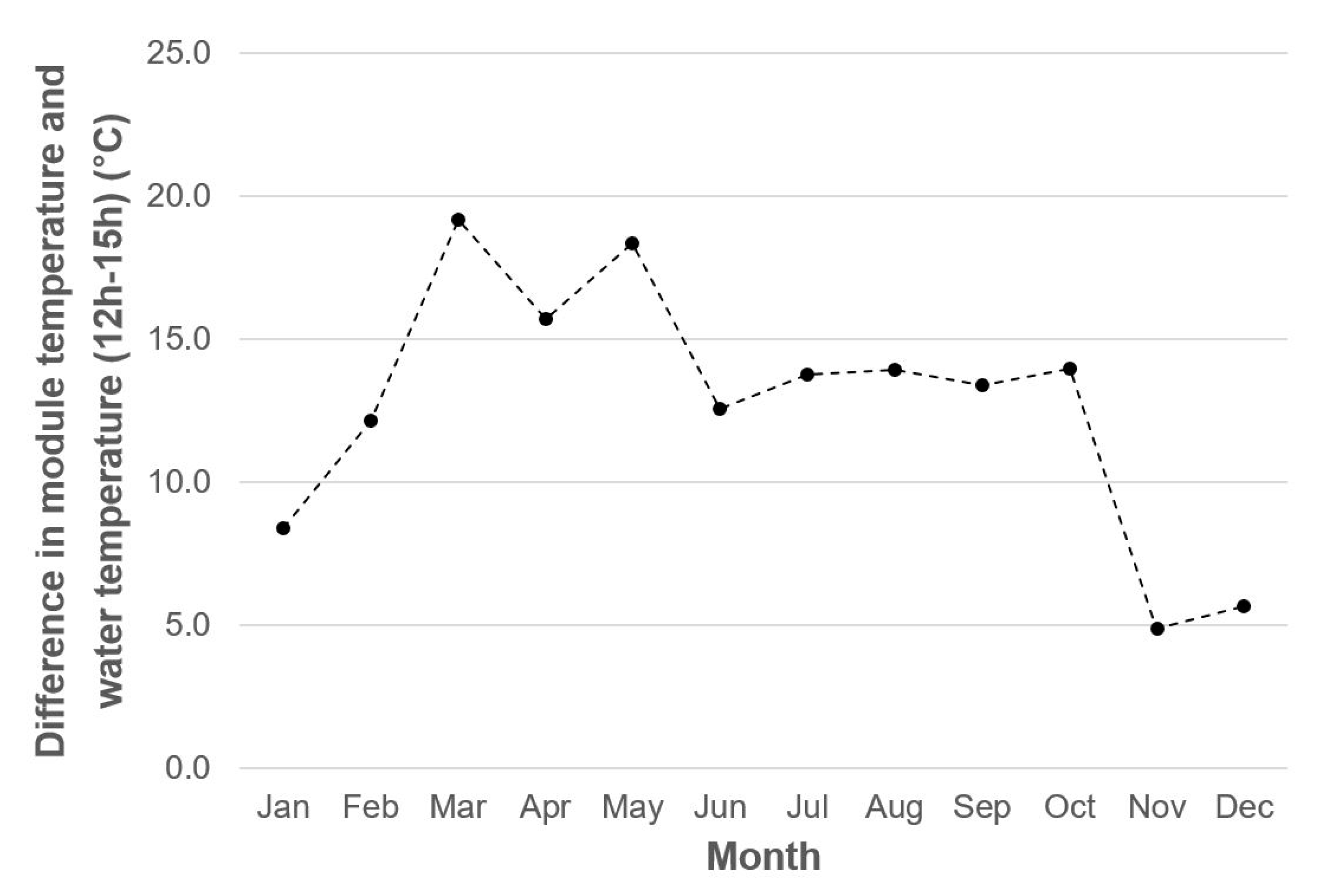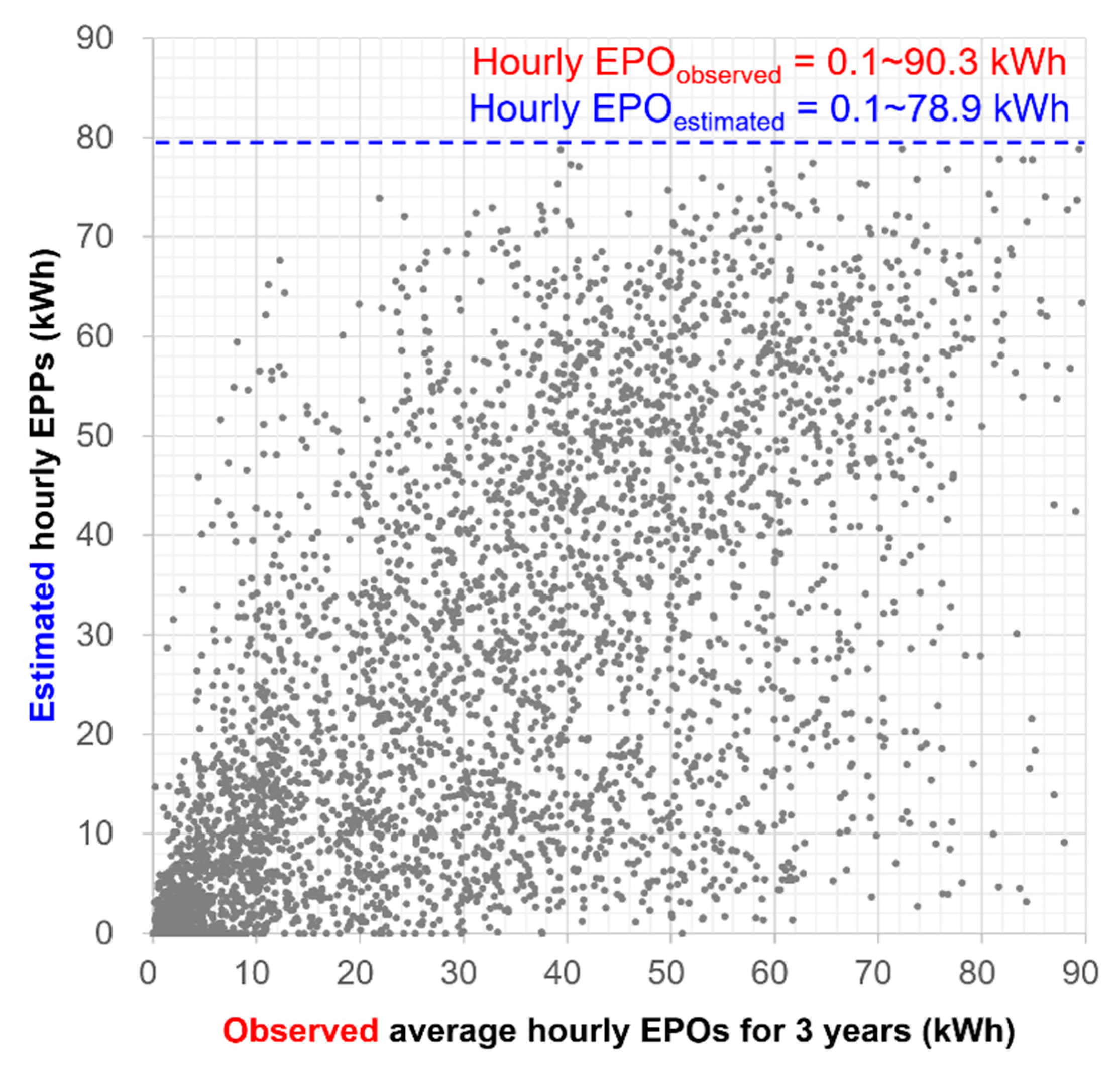1. Introduction
Floating photovoltaic (PV) systems are PV systems that float on the surface of dam reservoirs, quarry lakes, irrigation canals, or tailing ponds [
1]. Recently, the market for floating PV systems has drastically expanded worldwide because of their several strengths compared with PV systems installed on land. First, floating PV systems obtain higher electric power output (EPO) than PV systems on land because relatively low temperature water cools the PV panels. Second, because floating PV arrays are installed on water, national land can be conserved and used for other purposes that enable its efficient use [
2]. Third, unlike most PV systems on land, floating PV systems are less obtrusive since they are generally hidden from public view. Fourth, there are fewer rules and regulations for structures built on bodies of water. Fifth, this approach helps to control algae and create fish-spawning environments.
Floating PV systems as eco-friendly electricity generators also have attracted interest from the South Korean (henceforth, Korean) government and energy providers. The Korean government initiated a renewable portfolio standards (RPS) program beginning in 2012 that requires electricity providers to gradually increase their renewable energy EPO [
2,
3]. To meet the RPS program standard, various renewable energies, including PV, were investigated. However, the Korean peninsula is a small area and numerous existing PV systems in forest areas have caused slope failure of steep terrain and environmental degradation [
2,
4]. Conversely, the impact caused by a floating PV system has mostly been environmentally benign compared with land PV systems. Furthermore, because there are thousands of dam reservoirs and irrigation canals in South Korea that are appropriate for installing floating PV systems [
5], the Korean government made a plan to install floating PV systems on more than 30 dam reservoirs (550 MW) step by step until 2022 [
2]. Moreover, the Korean government applied a renewable energy certificate (REC) value of 1.5 to floating PV systems beginning in 2013, while the REC value for overland PV systems was set at 1.0.
In Korea, there have not been many long-term observations of EPO value (henceforth, EPO) data for different floating PV sites throughout the country; however, in order to select proper sites for systems or design floating PV projects in their early stages, an accurate estimation of EPO from a floating PV system, taking into account in situ conditions, is an essential first step.
Various researchers have studied feasibility assessments that have focused on EPOs from floating PV systems. Sahu et al. [
6] investigated the status and various design options (e.g., types, concepts, and commercial design) of floating PV power plants worldwide. Cazzaniga et al. [
1] reviewed performance analyses and design solutions for floating PV plants. Some work [
7,
8] has been done to estimate EPOs from floating PV systems by simulation, taking into account local meteorological data, physical characteristics of modules and inverter, and system design. However, these studies have aimed at predicting EPOs without any validation using observational data (i.e., actual EPO values), thus it is hard to interpret or accept the resulting EPOs. On the other hand, a few studies [
4,
9] have been carried out that have observed and analyzed the characteristics and patterns of monthly EPOs from floating PV systems on site. However, these studies have only analyzed the data obtained from the floating PV systems and lack the scientific estimation step in designing a floating PV project. Most previous studies have been limited in their discussion of feasibility studies for floating systems. Therefore, for a feasibility assessment, it is necessary to estimate EPOs from a floating system using existing meteorological data at an adequate level of confidence and then to interpret and validate EPOs using real EPOs observed on site.
The objective of this study is to analyze the estimation of EPOs from a floating PV system and to validate the results by comparing them with observed EPOs. In order to achieve this, a region for which observed EPO data are available was selected because reference values (i.e., actual EPOs) are necessary for error analysis in order to compare with estimation results. This study differs from previous studies in that it considers both estimation and validation to evaluate the feasibility of a floating PV project. This study did not consider economic assessment by electricity generation for the feasibility study of a floating PV system.
2. Study Area
In this study, the Hapcheon Dam, Hapcheon-gun, Korea, was selected as a study area for the analysis and validation of EPOs (
Figure 1). This dam is located in the Hwang River, a tributary to the Nakdong River. It is a multi-purpose dam with a height of 96 m, a length of 472 m, a total storage volume of 790 m
3, and a basin area of 925 km
2.
Floating PV system No. 1 (originally three systems existed) is present in Hapcheon Dam (
Figure 2), and details of the systems are summarized in
Table 1. The system was installed by the Korean public corporation K-water, which constructs, operates, and manages facilities for the comprehensive use and development of water resources in Korea. A fixed-type 99.36 kW
p floating PV system, No. 1, installed in October 2011, was selected as a target area to acquire and analyze the longest observed abundant data. System No. 1 was the first floating PV system demonstration plant on a dam reservoir in the world. It was installed in an area that is more than 200 m from land to ensure adequate water depth and avoid the shadow effects of the surrounding mountains.
3. Methods
The flowchart employed to estimate and validate the EPOs from the floating PV system in Hapcheon Dam, Korea, is shown in
Figure 3. In the first step, hourly typical meteorological year (TMY) data from Daegu city, physical characteristics of module and inverter, and the system design of the Hapcheon Dam were input into System Advisor Model (SAM) software to estimate EPOs from the floating PV system. In this step, the shadow effect of nearby small obstacles, analyzed by site investigation with SunEye equipment, was also entered into SAM software to conduct the energy simulation. Using three different sets of data, hourly EPOs were estimated using SAM software. In the second step, hourly EPO data from floating PV system No. 1, observed for more than four years, were obtained. These data were regarded as actual EPOs (reference values) for the validation in this study. In the third step, the hourly and monthly accumulated estimated EPOs, derived by SAM-based simulation, were quantitatively compared with the hourly and monthly accumulated observed EPO data in terms of statistical error.
3.1. Estimation of EPOs from a Floating PV Using SAM-Based Simulation
SAM software, developed by the United States National Renewable Energy Laboratory (NREL), was used to simulate the performance of the floating PV system in this study. This free software enables simulation of hourly EPO of PV systems and other renewable energy systems. The SAM software calculates the possible electrical power production capacity of the floating PV system by entering the hourly meteorological data (e.g., TMY data) and system design parameters (module and inverter models listed in
Table 2) into the SAM software. It requires module and inverter specifications along with information about the number of modules and inverters in the system. Module and inverter specifications can be input from a manufacturer’s data sheet, or from in-built libraries. The photovoltaic model of the SAM software adopts a couple of models, such as the empirical model, the physical model, and the hybrid model (e.g., Sandia model for module and inverter). Moreover, the SAM estimates losses caused by the effect of temperature on the module performance, and has options for calculating shading and other losses in the system. Based on the estimated power output, the economic feasibility and reduction of greenhouse gas emissions can also be assessed. Detailed models and equations to calculate power output of modules in the SAM software can be found in work by Song and Choi [
8] and Gilman [
10].
Unfortunately, the current version of SAM has no separate feature for floating PV systems. In seeking to address this problem, Song and Choi [
8] added 11% to the SAM output value by taking into account previously published experimental results that had shown that floating PV systems yielded 11% greater power output than their terrestrial counterparts. Several studies adopted a model that considers experimental expressions for cell temperature and related environmental characteristics to estimate EPOs by reflecting the natural cooling effect of the water environment to the PV module [
11,
12]. It is clear that the natural cooling effect does not occur at all electricity generation periods and occurs under relative temperature difference conditions. However, in practice, it is difficult to predict the exact time and degree of the natural cooling effect. Thus, general PV simulation functions in the SAM software were adopted in this study. Moreover, to consider efficiency improvement caused by the natural cooling effect on floating PV modules, 10% was added to the SAM output value. The evidence for multiplying 1.1 (110%) of the EPO values of floating PV is presented in
Section 4.3. This software requires three inputs, TMY data, the physical characteristics of the floating PV system, and shading matrix data, to estimate EPOs from the floating PV system.
TMY data are essential input parameters used to estimate EPOs from a floating PV system using SAM-based simulation. The TMY data are statistical hourly data for the specific site (e.g., global horizontal irradiance, direct normal irradiance, temperature, wind speed, wind direction, albedo, and other meteorological characteristics observed for 30 years, from 1981 to 2010) collected as part of the TMY weather data of the NREL National Solar Radiation Database. The Korean TMY data were processed by the Korea Institute of Energy Research, taking into account local meteorological characteristics. The reason why we used TMY data (observed from 1981 to 2010) is to secure the reliability of the meteorological data in predicting EPOs from a long-term perspective at a reliable level.
Although various meteorological characteristics were observed at the target area by the K-water corporation, these were insufficient to be used as hourly TMY data. Therefore, TMY data from Daegu city, which, among the 16 TMY data measurement points in Korea, is nearest to the target area and is approximately 45 km from the Hapcheon Dam (see
Figure 1), were adopted to estimate EPOs. As the SAM PV module employs hourly TMY data, it enables an hourly simulation of EPOs.
The physical characteristics of the PV module and inverter and the system-design parameters employed for the floating PV are listed in
Table 2. The PVM S240 model of the LSIS module and the DSP-3350k model of the Dasstech inverter were utilized at the target area. The system was composed of 414 modules (240 W
p for each). Details of the module technologies employed in this study can be found in [
13]. It was found that the fixed-tilt PV arrays of system No. 1 were installed at an installation angle of 33°, considering the local latitude.
Shading on a PV module hinders generation of electricity. To measure the shadow effects caused by nearby obstacles such as vegetation, the skyline was recorded and analyzed using a fish-eye lens camera (SunEye210). Detailed instructions for the fish-eye lens camera can be found in the work of Song and Choi [
14]. This enabled field analysis of the skyline at the PV site. The results of shadow-effect analysis were stored in the form of a shading matrix consisting of month-by-hour shading data for shading elements surrounding the PV site, as expressed by values between 0.0 (complete shielding of direct radiation reaching the PV system) and 1.0 (no shading effects) [
15].
3.2. Validation of Simulated EPOs from a Sloating PV
To validate the estimated EPOs from the floating PV system, they were compared with the actual EPOs observed at the target area in terms of three statistical errors in this study. In addition, the estimated EPOs were also multiplied by 1.1 and compared with the observed EPOs to reflect the higher efficiency of the floating PV system compared with that of the overland system.
At the target area, various electrical data and meteorological data, including hourly EPOs, water temperature, wind speed, and other meteorological data were observed for more than four years (from December 2011 to February 2016) by the K-water corporation. However, in the process of exploratory data analysis it was found that there were problems such as missing data and data errors in the 2011, 2014, and 2016 data. Thus, these data were excluded, with only the data from the other three years, 2012, 2013, and 2015, being considered for the validation of EPOs in this study. Inevitably, the EPOs vary from year to year according to the local meteorological conditions and the influence of the surrounding environment. As such, three-year average observed hourly EPOs were used as actual EPOs (reference values) to be compared with the estimated EPOs in this study.
A statistical error test was conducted to quantitatively validate the estimated EPOs. Errors were calculated by subtracting the actual EPOs (i.e., the three-year average observed hourly EPOs at the target area) from the EPOs estimated from the SAM-based simulation. Twenty-four values (12 EPOs estimated and corresponding 12 EPOs observed) and 17,520 values (8760 EPOs estimated and corresponding 8760 EPOs observed) were utilized to calculate statistical errors for hourly data and monthly data, respectively. Smaller errors indicate that the estimated hourly EPOs are accurate and the prediction approach is appropriate. The study employed the root mean square error (RMSE), mean bias error (MBE), and mean absolute percentage error (MAPE) statistical test methods using the following equations:
where
n indicates the number of data used and
et indicates the difference between the EPOs estimated from the SAM-based simulation (
xt) and the three-year average observed EPOs (henceforth, observed EPOs) (
yt).
5. Conclusions
In this study, hourly and monthly EPOs from the 99.36 kWp fixed-type floating PV system at the Hapcheon Dam, Korea, were estimated using SAM software, and the results were compared with three-year average observed (actual) EPOs. The results showed that both the observed and estimated monthly EPOs were higher in spring than in summer. Both the hourly and monthly estimated EPOs were lower than corresponding observed EPOs. These underestimations can be ascribed to the fact that the natural cooling effect of a water environment on the improvement of PV module efficiency was not considered in the SAM-based simulation. The difference in errors before and after multiplication by 1.1 (110%) in both the monthly and the hourly approach were examined. The error estimation results showed that the SAM simulation approach enables estimation of monthly EPOs with an error of approximately 15% (the MAPE value). Moreover, based on the empirical results showing that floating PV efficiency is approximately 110% of overland PV efficiency, 10% was added to the SAM-based estimated EPO results. Consequently, it was possible to estimate the monthly EPOs with an error of approximately 9% when taking into account the efficiency improvement caused by the natural cooling effect of water. Hourly EPOs were shown to have reduced MBE values when the efficiency enhancement was applied. With only overland PV software, these results show that the suggested SAM-based approach can provide relatively more reliable monthly EPOs in the feasibility assessment step of designing floating PV projects. The results obtained in this study can be used as basic data to design and manage floating PV systems. Furthermore, the suggested simulation approach can be applicable to other floating PV sites.
It should be noted that the natural cooling effect does not occur during all electricity generation periods. Thus, simply multiplying all of the estimated PV output is not the best option to take into account efficiency improvement caused by the natural cooling effect of water, as this effect occurs only during specific temperature conditions (i.e., lower water temperature, higher air ambient temperature, and higher PV cell temperature). Therefore, further research is necessary to identify when natural cooling effects occur and to examine the degree of influence of environmental conditions on PV module efficiency. In addition, to date, no PV software has a separate feature for floating PV systems. Thus, it is necessary to develop a simulation algorithm appropriate for floating PV systems that takes into account the environmental effects of a water environment, such as the natural cooling effect, wave effects caused by high wind speed, reflected irradiance, and other characteristics.
This study employed TMY data from Daegu city as input data for the SAM-based simulation because of insufficient meteorological data available for the target area. In future, if data are available, it would be useful to compare local meteorological data from the Hapcheon Dam with TMY data from Daegu city to identify the parameters that may have caused a large difference between the observation data and the estimation data. This could also determine whether the use of TMY data from Daegu city is appropriate or not in the simulation of EPOs from the PV system at the Hapcheon Dam. In future work, it would be interesting to examine the multi-criteria effects that the investments in question can generate because investments in solar energy generate not only financial but also social and environmental impacts [
17,
18].
